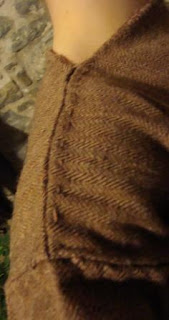A fantastic stretch of Roman frontier works can be traced through the forests, making it an excellent route.
This time we kept to a short route, up the Feldberg and back... at -20 degrees celsius!
The clothing has to be well reconstructed to be both authentic and practical. For me this means no synthetics, lots of wool and no cotton, hence the old trekkers adage, 'in the hills cotton kills'.
I wore a long sleeved tunic as a base layer, a standard thick woollen tunic as a mid layer, with a linen and felt arming jack, covered by mail and a heavy cloak. Two pairs of woollen socks were worn on the feet, beneath enclosed boots. A needle bound hat was also covered by the cloak. With all this, I was more than adequately warm.
The only problem area were the legs. The leather breeches were not very warm, and next time I will opt for wool. Shin wraps would also have been beneficial, as my calf muscles were working to climb up a mountain whilst being exposed to sub zero temperatures, and ached for a few days afterwards.
We were only out for three hours, but the clothing kept us warm. Some people thought we were mad to have gone out in Roman clothing in these temperatures, however, the clothing was for the most part very practical.
Wool is all too often an underestimated material, though recent research has shown that it can compete with some of the best synthetics on the market. It has even been used to scale Everest...




















